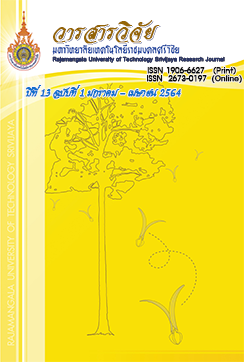Antioxidant Activity of 3 Cultivars Rambutan Peel Extract in Chanthaburi Province
Keywords:
Rambutan Peel Extract, Rongrien, antioxidant activityAbstract
The aim of this study was to determine antioxidant property of 3 cultivars rambutan peel extract such as Rongrien, Seechompoo and Seetong from Chanthaburi fruit market. Each dried rambutan peels were extracted for triplicate 3 days with 1:10 ratio of 95% ethanol before dried by rotary evaporator. Crude extract were evaluated on its antioxidant properties using 2,2-diphenyl-1-picrylhydrazyl (DPPH) radical scavenging activity, 2,2’-azino-bis (3-ethylbenzthiazoline-6-sulphonic acid) (ABTS) radical cation decolorization assay and ferric ion reducing antioxidant power (FRAP) assay. Best on DPPH radical scavenging assay and ABTS radical scavenging assay, crude extract from Rongrien cultivar showed significantly (p≤0.05) highest antioxidant activity (IC50 =8.795 µg/ml and 0.374 mg/ml, respectively). Moreover, crude extract from Rongrien cultivar also founded the highest FRAP assay value (6,740 µmol/g) when determined by using FRAP assay. Interestingly, the 3 cultivars rambutan peel extract exhibited higher antioxidant activity than those control (BHT and α-Tocopherol) (p≤0.05). This research show that crude from the rambutan peel could be the interesting source of antioxidants for development of various products in the future
References
Anshory, H. and Tamimy, A.S. 2006. Antioxidant activity of ethanol extract of rambutan (Nephellium lappaceum L.) fruit peel against DPPH free radical suppression by spectrophotometer (In Bahasa Indonesia). Scientific Journal of Pharmacy 3(1): 9-15.
Cheng, H.S., Ton, S.H. and Kadir, K.D. 2016. Ellagitannin geraniin: A review of the natural sources, biosynthesis, pharmacokinetics and biological effects. Phytochemistry Reviews 16: 159-193.
Dilokkunanant, U., Mongkolsook, Y., Kongkathip, N., Sukatta, U., Rattana, W and Rakthaworn, P. 2004. Antimicrobial activity of betel vine (piper betle Linn.) extracts in Thailand, pp. 291-297. In Proceedings of 42nd Kasetsart University Annual Conference. Natural Resource and Environmental Economics. Kasetsart University, Bangkok. (in Thai)
Gusman, J.A. and Tsai, P.J. 2015. Extraction of antioxidant compounds from rambutan (Nephelium lappaceum L.) peel as agricultural waste in Taiwan. Journal of Tropical Crop Science 2(2): 10-16.
Hernández, C., Ascacio-Valdés, J., De la Garza, H., Wong-Paz, J., Aguilar, C.N. and MartínezÁvila, G.C. 2017. Polyphenolic content in vitro antioxidant activity and chemical composition of extract from Nephelium lappaceum L. (Mexican rambutan) husk. Asian Pacific Journal of Tropical Medicine 10(12): 1201-1205.
Herrero, M., Cifuentes, A. and Ibañez, E. 2006. Sub and supercritical fluid extraction of functional ingredients from different natural sources: Plants, food-by-products, algae and microalgae - a review. Food Chemistry 98(1): 136-148.
Hidayat, W.N., Ridhwan, A.W. and Azamn, S. 2011. Promising effect of Nephelium lappaceum rind extract as cancer chemopreventive agent through apoptosis and cell cycle arrest mechanisms on human osteosarcoma cells. pp. 163-169. In Proceedings of the University Malaysia Terengganu 10th International Annual Symposium UNTAS2011. Faculty of Science and Technology. University of Malaysia, Malaysia.
Kondo, S., Tsuda, K., Muto, N. and Ueda, J.E. 2002. Antioxidative activity of apple skin or flesh extracts associated with fruit development on selected apple cultivars. Scientia Horticulturae 96(1-4): 177-185.
Kronholm, J., Hartonen, K. and Riekkola, M.L. 2007. Analytical extractions with water at elevated temperatures and pressures. TRAC Trends in Analytical Chemistry 26(5): 396-412.
Kubola, J. and Siriamornpun, S. 2008. Phenolic contents and antioxidant activities of bitter gourd (Momordica charantia L.) leaf, stem and fruit fraction extracts in vitro. Food Chemistry 110: 881-890.
Palanisamy, U.D., Cheng, H.M., Masilamani, T., Subramaniam, T., Ling, L.T. and Radhakrishnan, A.K. 2008. Rind of the rambutan, Nephelium lappaceum, a potential source of natural antioxidants. Food Chemistry 109(1): 54-63.
Palanisamy, U.D., Ling, L.T., Manaharan, T. and Appleton, D. 2011. Rapid isolation of geraniin from Nephelium lappaceum rind waste and its anti-hyperglycemic activity. Food Chemistry 127(1): 21-27.
Re, R., Pellegrini, N., Proteggente, A., Pannala, A., Yang, M. and Rice-Evans, C. 1999. Antioxidant activity applying an improved ABTS radical cation decolorization assay. Free Radical Biology & Medicine 26: 1231-1237.
Rohman, A. 2017. Review article Physico-chemical properties and biological activities of rambutan (Nephelium lappaceum L.) fruit. Research Journal of Phytochemistry 11(2): 66-73.
Samuagam, L., Sia, C.M., Akowuah, G.A., Okechukwu, P.N. and Yim, H.S. 2015. In vivo antioxidant potentials of rambutan, mangosteen and langsat peel extracts and effects on liver enzymes in experimental rats. Food Science and Biotechnology 24(1). 191-198.
Skerget, M., Kotnik, P., Hadolin, M., Hras, A.R., Simonic, M. and Knez, Z. 2005. Phenols, proanthocyanidins, flavones and flavonols in some plant materials and their antioxidant activities. Food Chemistry 89(2): 191-198.
Teerananont, N. 2008. Study of using the rambutan seeds from rambutan in syrup can industrial to produce biodiesel. Master of Engineering, King Mongkut’s University of Technology Thonburi. (in Thai)
Thitilertdecha, N., Teerawutgulrag, A., Kilburn, J.D. and Rakariyatham, N. 2010. Identification of major phenolic compounds from Nephelium lappaceum L. and their antioxidant activities. Molecules 15(3): 1453-1465.
Wei, A. and Shibamoto, T. 2007. Antioxidant activities and volatile constituents of various essential oils. Journal of Agricultural and Food Chemistry 55(5): 1737-1742.
Zhu, K., Zhou, H. and Qian, H. 2006. Antioxidant and free radical-scavenging activities of wheat germ protein hydrolysates (WGPH) prepared with alcalase. Process Biochemistry 41(6): 1296-1302.
Downloads
Published
How to Cite
Issue
Section
License
The content and information in the article published in Journal of Rajamangala University of Technology Srivijaya It is the opinion and responsibility of the author of the article. The editorial journals do not need to agree. Or share any responsibility.







